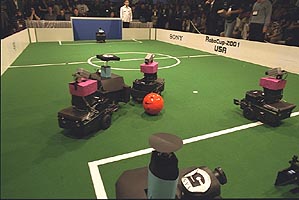Artificial Intelligence
 Fig. 1: The famaous cyborgs of Star Wars. |
Artificial Intelligence, or AI, concerns the studies and techniques aimed at producing machines
(electronic calculators in particular) capable of solving problems and reproducing activities
belonging to human intelligence. AI's main applications can be found in
logics![]() ,
robotics,
machine learning
,
robotics,
machine learning![]() ,
applied and theoretical computer science.
,
applied and theoretical computer science.
The expression Artificial Intelligence is an evident oxymoron, attributing to the artificial what is most natural,
i.e. intelligence, the highest quality of human nature. This oxymoron is in itself provocative, since
many people seriously question whether a machine can actually be intelligent, in the sense that
this word is applied to the human mind (see below, IV). However, definitions like this are too generic since they
can be easily adapted to indicate the whole area of informatics, and automation techniques,
whereas these two disciplines are in no way part of AI.
It is difficult to form precise definitions, because on
the one hand this subject is developing at a very fast pace,
so definitions of its field of competence could exclude future developments which
may belong to it a priori, and on the other hand, because it is at the same time
both science and technique, and a frontier discipline, a fascinating meeting point where different areas of knowledge come together:
logic, informatics, psychology,
neurosciences![]() and philosophy. Therefore, instead of delimiting, it is better to list and describe its main characteristics and the main
areas of application.
and philosophy. Therefore, instead of delimiting, it is better to list and describe its main characteristics and the main
areas of application.
Men or machines?
A fundamental distinction causing heated philosophical debate is between so-called weak AI and strong AI: supporters of weak AI are content with considering machines as behaving as if they were intelligent; strong AI supporters consider machines as similar to man to the point that they possibly have self-consciousness. It is easy to understand how these distinctions intertwine: strong AI refers to machines thinking in a human way, while weak AI refers to operating machines.
Philosophy vs. EngineeringWith regard to technical
creations, we can make the distinction between a functional, or behavioral
approach, regardless
of the structure provided with the elaborator seat of the intelligence, and a
structural, constructionist or connectionist approach, aimed at
achieving the performance of the human mind by reproducing its structure in some
way.
With a slight shift of perspective, the first approach was called emulationist,
the second simulationist: the supporters of the latter believe that only by
reproducing the human mind as faithfully as possible can we achieve a level of
performance comparable to it; the supporters of the former, on the contrary,
believe that mind functions are not a matter of structure, but of performance,
and performance may be achieved even through completely different structures,
and perhaps with even greater success. Both solutions have provided a wealth of
results, but the second, despite minority support, is of
special importance, because
it led to the creation of neural networks. These
are imitations of the animal mind - extremely rough, but extremely interesting
from a cognitive and technical point of view for having established connections
with neuroscience which have been
of great significance for AI and for
neuroscience itself. In the end the two approaches converge, because after some
attempts at producing dedicated physical structures (at a hardware level),
neural networks are now made mainly within calculation programs (at a software
level) and then executed on normal calculators.

Fig. 2: A match of the Robocup competition.